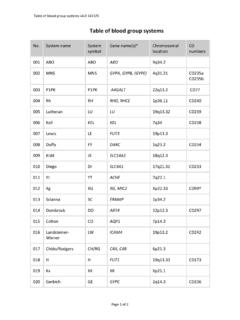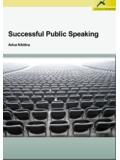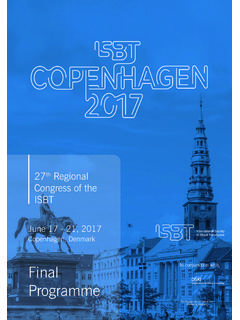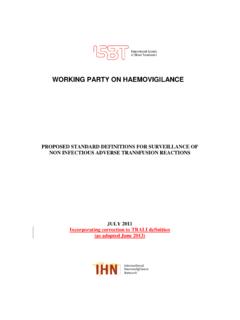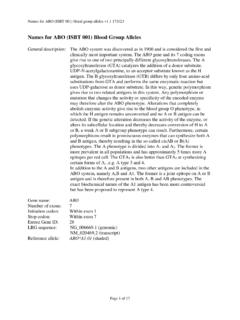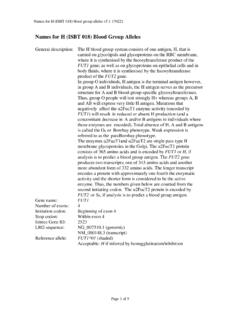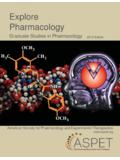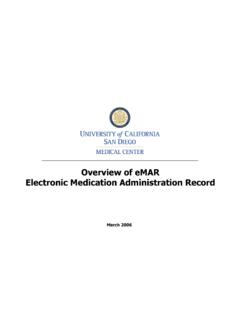Transcription of Vox Sanguinis - International Society of Blood …
1 Vox SanguinisInternational Journal of Blood Transfusion MedicineVolume 98, Supplement 1, February 2010 International Society for Blood TransfusionISBT Guidelines for Validation of Automated Systems in Blood clxxxv12/17/2009 12:05:23 PM12/17/2009 12:05:23 PMThis document has been written by the International Society of Blood Transfusion Working Party on InformationTechnology Validation Task who have participated in the writing of this document:Janet Sampson, Welsh Blood Service, Wales (Co-Chair)Robin Nozick, R. F. Nozick and Associates, USA (Co-Chair)Paul Ashford, ICCBBA, USAW olfgang Boecker, Fresenius Kabi Deutschland GmbH, GermanyPia Bruce, Finnish Red Cross Blood Service, FinlandDr Patrick Coghlan, Australian Red Cross Blood Service, AustraliaJohn Davies, SwedenRodeina Davis, Blood Center of Wisconsin, Milwaukee, USAPat Distler, ICCBBA, USAT homas Dullaart, Sanquin, The NetherlandsPeggy Dunn, Puget Sound Center, Seattle, USALone Espensen, Odense University Hospital, DenmarkOluwafemi Faseemo, Christus Spohn Health system , Corpus Christi, Texas, USAS imon Fournier, He ma-Que bec, Montre al, CanadaShankar Goudar, Carter BloodCare, Bedford, Texas, USAS andy Hedberg, SoftwareCPR, USAS usan Hudson, American Red Cross, Washington , USAG erhard Jirsa, Austrian Red Cross Blood Donation Center for Vienna, Lower Austria and Burgenland, Vienna, AustriaBonnie Lupo, Continuum Health Partners, New York, USASue McDonnell.
2 Irish Blood Transfusion Service, IrelandThe publication of version 2 of these guidelines reflects the enormous contibution made by the International Society ofBlood Transfusion Working Party on Information Technology Validation Task Force members listed above whose contribu-tions covered both authorship and reviewing of material. In addition it is appropriate to recognise the contribution made bythe following colleagues in producing version 1 of the guidelines published in 2003:Mike Clark, EnglandChristian Desaint, FranceCarlos Izaguirre, CanadaAngelika Kawaters, GermanyCharles Munk, SwitzerlandIntroductionThe ISBT Guidelines for Validation and Maintaining the Validation State of Automated Systems in Blood Banking were firstpublished in 2003 and have since been recognized by Blood establishments and suppliers of automated systems as a usefuldocument in promoting a standardized approach to the complexities of validation projects for critical computer systems andequipment in Blood 2 of the guidelines, replacing the previous version, is renamed ISBT Guidelines for Validation of Automated Sys-tems in Blood Establishments, and has been written to take account of changes within the regulatory environment anddevelopments in validation methodology.
3 And to ensure that the document remains relevant to the validation challengesfaced by Blood establishments today and for those they are likely to face in the comprehensive re-write of the guidelines expands the scope of validation activities covered and takes account of, andreflects, the recent developments of ICH Q8, ICH Q9, ICH Q10, GAMP 5 and PIC S. Specific additions include the following:a clearer definition of validation and its relationship to an organisation s Quality Management system (QMS); the effect ofrisk assessment on what and how much validation is necessary; sections on validating Data Migration software and NetworkInfrastructure; performing Supplementary Qualifications; the use of validation platforms; and validating software Blood establishment bears the responsibility for the regulatory compliance of the automated computerized systemsused. Full validation of the computerized system is required for systems that are critical to product quality (informationmanagement, storage, tools for operational decision-making, and control).
4 These guidelines do not advocate a particularvalidation methodology but do promote the Quality Risk Management approach to validation advocated by GAMP 5 andICH Q9, a life cycle approach within the QMS, and the use of risk assessments to define the validation strategy for criticalsystems. The guidelines are not intended to present a new concept of validation but to be relevant and applicable to all bloodestablishments regardless of the approach to validation adopted by each. They were originally built upon other field valida-tion experiences and have been updated with the experience gained in validating automated systems in Blood establish-ments. The guidelines should be adapted to each Blood establishment s needs considering: the size and type of the organisation; the impact of risk in Blood establishments; the need to have reliable automation systems; the diversity of activities taking place in Blood establishments; the evolution of regulations and the national legislation; the possibility to leverage the supplier documentation and knowledge; and the resources needed to implement a validation is important that the approach to validation used by a Blood establishment should allow provision for the process to bescalable to the functionality of the system , the validation of a centrifuge is less complex than that for a bespoke bloodmanagement system .
5 The guidelines include an updated appendix which lists common Blood establishment equipment andthe recommended approach to their following were chosen as the main references for the version 2 of the ISBT guidelines: GAMP 5 A Risk-based Approach to Compliant GxP Computerized Systems [1]; Guidance for Industry ICH Q8 Pharmaceutical Development [7]; Guidance for Industry ICH Q9 Quality Risk Management [8]; Guidance for Industry ICH Q10 Pharmaceutical Quality system [9]; FDA Guidance for Industry General Principles of Software Validation [2]; PIC S Validation Master Plan Installation and Operational Qualification Non-Sterile Process Validation Cleaning Valida-tion [3]; PIC S Good Practices for Computerised Systems in Regulated GxP Environments Guidelines [4].The benefits of validation have remained as follows: improve the use of technology; improve the business benefits; improve the relationship between stakeholders (users, suppliers, authorities, etc.)
6 ; improve operational efficiency; reduce the risk of failure; improve compliance with question often posed by Blood establishments is, How much validation do we need to perform? Validation is essentially a component of the organization s quality management system so this question could berephrased as, How much quality do we need? The product quality and cost benefits to be achieved by an organizationthrough adopting the Total Quality Management principles of customer satisfaction, employee involvement and continuousimprovement are well-established and are equally applicable to validation. The objective of validation is to produce docu-mented evidence that provides a high level of assurance that all parts related to the use of an automated system will workcorrectly and answer to the question, therefore, is that the Blood establishment needs to ensure that enough of the right work isdone by the right people to achieve system acceptance in a way that satisfies the Quality this in mind it is worth considering what makes validation projects successful, namely: Senior Management commitment; Sufficient resources; Competent project management; Collaborative team approach, users technical reps validation QA IT professionals; Risk assessment; Cost is a complex process.
7 The skillsets and experience of the team are very important in ascertaining the scope ofwork to be carried out and that not too much, or unnecessary, work is performed. There may be a temptation to disregardparticular elements to reduce workload. This approach is not recommended and should be , the process is easier to perform with qualified staff and where validation processes are already established andembedded into the those organisations who are about to adopt validation practices and who may be lacking validation resources it isimportant to consider the following: It takes time for validation processes to be developed and become embedded in the organization. In the meantime, theblood establishment wants to continue with its activities. It is essential that validation and acceptance of systems is performed before systems are used operationally. Use should be made, where possible, of supplier system and test documentation to reduce the Blood establishment s qual-ification effort.
8 When performing retrospective validation of equipment it is worth considering whether the existing QMS documentationmay be sufficient to comply with the minimum regulatory requirements of demonstrating control and approval via, forexample, specification, risk assessments, qualification, traceability and validation Validation Task Force would like to thank the following organisations for their Red Cross, Washington DC, USAA ustralian Red Cross Blood Service, AustraliaAustrian Red Cross, Blood Donation Center for Vienna, Lower Austria and Burgenland, Vienna, AustriaCarter BloodCare, Bedford, Texas, USAC hristus Spohn Health system , Corpus Christi, Texas, USAC ontinuum Health Partners, New York, USAF innish Red Cross Blood Service, FinlandFresenius Kabi Deutschland GmbH, GermanyHe ma-Que bec, Montre al, CanadaICCBBA, USAI rish Blood Transfusion Service, IrelandOdense University Hospital, DenmarkPuget Sound Center, Seattle, USAR.
9 F. Nozick and Associates, USAS anquin, The NetherlandsSoftwareCPR, USAB lood Centre of Wisconsin, USAW elsh Blood Service, WalesConflicts of interestRobin Nozick declares that she is an Executive of a company which performs Validation and other Quality ManagementServices for Clinical Laboratories and Transfusion Services. All other authors have declared no conflicts of Overview12. Purpose13. Scope14. Responsibility15. Change Project change Operational change system inventory26. Validation process throughout automated system Start up of User Requirements Specification (URS) system URS Supplier system Financial Risk Validation Validation approach and content of the validation Validation Data Execute and Perform migration Infrastructure Servers and Network Business continuity Problem Validation report and final Handover (go-live) Validation state Calibration and Preventative Software patches service packs Training and Suppliers Periodic Performance system retirement137.
10 User access system access policies148. Back-up and recovery149. Archive and record retention1410. References1411. Reading list1512. Acronyms1513. Glossary16 Appendix 1 Documentation18 Appendix 2 Classification of automated systems19 ISBT Guidelines for Validation of Automated Systems inBlood Establishments1. OverviewEvery Blood banking organization must have a QualityManagement system . This should include a section on vali-dation ( Validation Master Plan or Validation Policy)that describes the organisation s policy regarding the vali-dation of equipment, facilities, utilities, methods, processesand automated systems required during the procurement,production and use of Blood components. An organisation svalidation policy should comply with the regulatoryrequirements applicable in the country of guidelines address the validation needs for auto-mated systems, those that have some degree of com-puter control.
